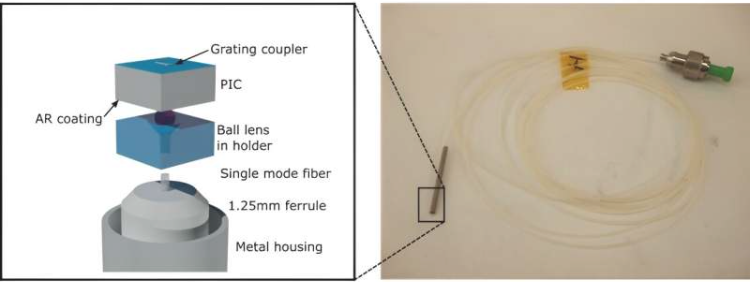décembre 19, 2023
590
Analogous to electronics, photonic circuits can be condensed onto a chip, resulting in a photonic integrated circuit (PIC). Despite the nascent nature of these advancements compared to electronics, this field is progressing rapidly. Nevertheless, a pivotal challenge lies in the conversion of a PIC into a functional device, necessitating adept optical packaging and coupling strategies to facilitate the ingress and egress of light from the PIC.

For instance, in optical communication, establishing a connection with optical fibers is imperative for transporting light pulses over considerable distances. Alternatively, the PIC may encompass an optical sensor reliant on external light for its readout. Given that light on a PIC traverses minute channels with sub-micrometer dimensions, denoted as waveguides, the optical coupling process is exceedingly intricate and demands precise alignment between the PIC and external components. Owing to the fragility of optical components, meticulous packaging of the PIC is indispensable for ensuring device reliability.
The research team led by Prof. Van Steenberge and Prof. Jeroen Missinne at Ghent University and imec is actively developing solutions to surmount the challenges associated with packaging and integrating PICs for cutting-edge telecommunication systems, sensors, and biomedical devices. A key focus of their efforts involves the utilization of miniature lenses (microlenses) to facilitate seamless connections between the optical channels on PICs and external optical fibers or other elements. They have successfully demonstrated the integration of microlenses into the PIC during its fabrication process or the incorporation of external microlenses during the packaging phase.
In a specific application, a small ball lens with a diameter of 300 micrometers was employed to establish an efficient connection between a sensor on a PIC and an optical fiber, which, in turn, could be linked to standard readout equipment. Furthermore, the paper delineates the essential steps taken to transmute the PIC into a functional and fully packaged miniature sensor probe, boasting a diameter of less than 2 mm. The optical sensor developed in this demonstration is a Bragg grating temperature sensor with the capacity to measure temperatures up to 180°C.
This sensor was realized within the framework of the European SEER project, conducted in collaboration with Argotech (Czech Republic) and the Photonics Communications Research Laboratory at the National Technical University of Athens (Greece). The overarching objective of the project is to integrate optical sensors into the manufacturing processes for composite parts, such as those utilized in aircraft, with the ultimate aim of optimizing processes, conserving energy, and reducing costs.